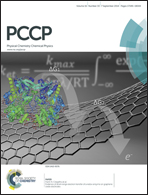A DFT + U study of acetylene selective hydrogenation over anatase supported PdaAgb (a + b = 4) cluster†
Abstract
It is well known that the addition of Ag into Pd can promote the selectivity of acetylene hydrogenation to ethylene, and early theoretical studies focus on ideal single crystal model catalysts, so it is worth studying relatively realistic catalyst models, such as metal oxide supported PdAg systems. In this work, the reaction mechanisms for acetylene selective hydrogenation on the anatase TiO2(101) supported PdaAgb (a + b = 4) cluster are studied by density functional theory calculations with a Hubbard U correction. The results show that Ag addition to the Pd4 cluster reduces the interaction between the PdAg cluster and the support, and the possible reason is that the amount of electron transfer from the TiO2 support to the PdAg cluster decreases with increasing number of Ag atoms. Consequently the adsorption energies of acetylene and ethylene would become smaller on the anatase supported PdAg cluster as compared to that on the anatase supported Pd4 cluster, and this may help to enhance the selectivity of ethylene formation. Moreover, the reaction kinetics study of acetylene hydrogenation on anatase TiO2(101) supported PdAg cluster shows that the activation energy of the hydrogenation step is higher on the PdAg cluster than that on the pure Pd4 cluster, and thus reduces its catalytic activity. Importantly, the present calculation results suggested that the selectivity of ethylene formation, which is defined as the energy difference between the adsorption energy of ethylene and the barrier for its further hydrogenation, varies with the ratio of Pd/Ag in the PdAg cluster: the Pd3Ag system shows relatively low selectivity compared to that of the pure Pd4 cluster, whereas Pd2Ag2/PdAg3 displays higher selectivity than that of the pure Pd4 cluster. Furthermore, our present results demonstrated that the anatase support plays a key role in the acetylene hydrogenation processes: on one hand, it reduces the reaction activity of acetylene hydrogenation processes compared to the Pd2Ag2/Pd(111) and Pd2Ag2 clusters; on the other hand, it enhances the selectivity of ethylene due to its lower desorption energy. It was also found that the carbon species inside the Pd2Ag2 cluster has little effect on the catalytic selectivity towards ethylene formation, whereas the hydrogenation catalytic activity is enhanced significantly. Finally the role of the Pd2Ag2–anatase interface on the catalytic properties of acetylene hydrogenation was studied, and it was found that the interface can increase the activity of acetylene hydrogenation but the selectivity is not improved.


 Please wait while we load your content...
Please wait while we load your content...